10 Best Steps for Small Farm Alpaca Fiber Processing
You’ll want to start by understanding your alpacas and their fiber type, then carefully sort and skirt the fleece to remove debris. Prepare it gently for washing using hot water and a mild detergent, and dry it thoroughly outdoors. Use combing or carding to align fibers, then blend or dye as desired. Finally, spin and finish your yarn, setting the twist for durability. Keep going to explore each step in detail and enhance your fiber-crafting skills.
Key Takeaways
- Shear alpacas once yearly in spring, taking 5-10 minutes per animal to collect clean fiber efficiently.
- Gently sort fleece by removing dirt, guard hairs, and second cuts while preserving fiber quality.
- Wash fiber in hot water with gentle detergent, soak without agitation, rinse thoroughly, and dry outdoors on mesh.
- Comb or card fibers to align and prepare for spinning, using light moisture to reduce static and improve handling.
- Spin singles with even twist, ply for balance, then wash and set yarn twist before labeling with fiber content and yardage.
Understanding Alpacas and Their Fiber
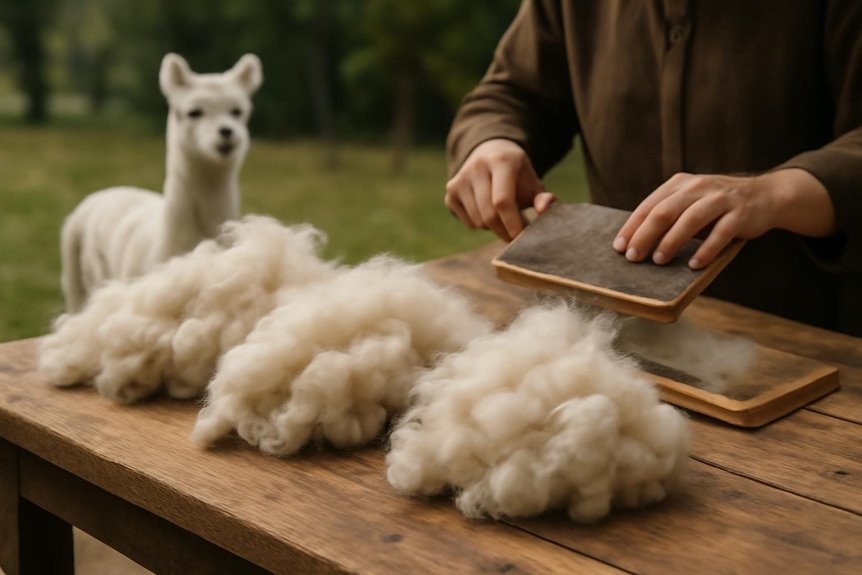
Although alpacas are related to camels, you’re more likely to know them for their incredibly soft, warm, and hypoallergenic fiber, which surpasses sheep wool in quality. Alpaca fiber comes in 22 natural shades, offering a rich palette for your textile projects. You’ll encounter two main types: huacaya, with a fluffy, wooly texture, and suri, featuring long, silky locks. The fiber is sheared once a year, usually in spring, taking just 5-10 minutes per animal since alpacas lack lanolin and don’t need pre-cleaning. Alpaca fiber’s smooth feel and excellent drape, with staple lengths ranging from 2 to 6 inches for huacaya and longer for suri, make it ideal for a wide variety of fiber arts and garments.
Identifying Key Fiber Characteristics
To make the most of alpaca fiber in your projects, you’ll want to recognize its key characteristics. Alpaca fiber comes in two main varieties: huacaya and suri. Huacaya fiber is wooly and elastic, with staple lengths ranging from 2 to 6 inches, while suri fiber features long, silky locks and a smoother texture. Both types offer a smooth feel and lovely drape, prized for high-quality textiles. Unlike sheep wool, alpaca fiber lacks lanolin, making it hypoallergenic and cleaner, though it still needs careful removal of plant matter. Additionally, alpaca fiber naturally appears in 22 shades, from browns to blacks, giving you diverse color options. Understanding these traits helps you handle and process fiber effectively for your small farm.
Sorting and Skirting the Fleece
When you start sorting and skirting the fleece, you’ll spread it out on a screen to carefully remove dirt, guard hairs, and debris. Skirting the fleece is essential even though alpaca fiber is generally cleaner than sheep’s. You’ll want to gently handle the fleece to avoid damaging the soft fibers while sorting out second cuts—shorter pieces left from missed shearer passes. Focus on removing these lower-quality fibers and any contaminants to guarantee only the cleanest, highest-quality fiber moves forward. Organizing the fleece into manageable portions during sorting and skirting the fleece will make the next steps smoother. By maintaining this attention to detail, you’ll protect the integrity of your alpaca fiber and set a solid foundation for successful processing.
Preparing the Fleece for Washing
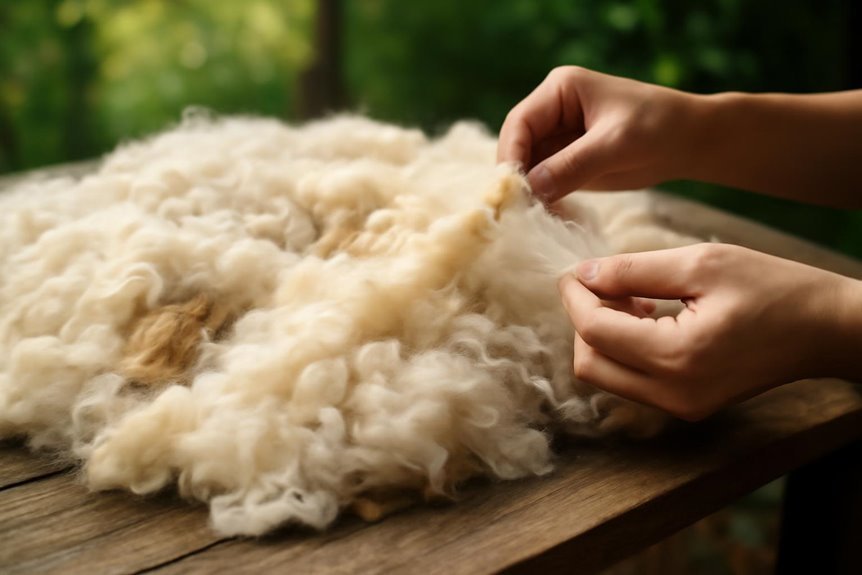
Since you’ve already skirted the fleece to remove dirt and debris, you’re ready to prepare it for washing. Skirting the fleece thoroughly is essential to minimize vegetative matter and impurities that could complicate cleaning. Alpaca fiber lacks lanolin, making it easier to wash than sheep wool, but you still want to handle it with care. Divide your fleece into manageable 4-ounce batches; this size supports effective processing and accounts for about a 10% waste factor during washing and preparation. To keep fibers from tangling, place each batch into zippered mesh laundry bags. These bags allow water and detergent to penetrate while keeping the fleece contained. By carefully preparing your fleece this way, you’ll set the stage for a smooth, efficient washing process.
Washing and Drying the Alpaca Fiber
When washing your alpaca fiber, you’ll want to use hot water around 130°F and a small amount of gentle detergent like Dawn to avoid felting. It’s important to soak without agitation and rinse thoroughly with hot water until the fiber is clean. After washing, drying your fiber outdoors on hardware cloth while fluffing and turning it helps remove any leftover debris and speeds up the drying process.
Washing Techniques
Although alpaca fiber requires gentle handling to prevent felting, you can effectively wash it in a machine using hot water (130°F) and a small amount of Dawn dish detergent, soaking it for 20 minutes without agitation. Use your washing machine carefully, placing fiber in zippered mesh laundry bags and working in 4-ounce batches to keep it manageable. Repeat the washing process with minimal detergent until the rinse water runs clear, ensuring all dirt is removed. After washing, spin the fiber without rinse water to extract excess moisture. Then, dry it outdoors on hardware cloth, fluffing and turning regularly to eliminate any remaining vegetative matter. These washing techniques help maintain fiber quality and cleanliness, preparing it perfectly for the next stages of processing.
Detergent and Temperature
Even if you’re new to alpaca fiber washing, you’ll find that using hot water at 130°F combined with just a small amount of Dawn dish detergent effectively cleans the fiber without causing felting. The detergent gently removes dirt and impurities while preserving the delicate structure of the fibers. Soak your alpaca fiber in this warm detergent solution for about 20 minutes without agitation to avoid matting. After soaking, drain and spin out excess water carefully. You may repeat the washing with minimal detergent if necessary. For final rinses, use hot water until it runs clear, ensuring no detergent or dirt remains. Since alpaca fiber lacks lanolin, it’s naturally cleaner and requires less detergent and pre-washing, making your process easier and more efficient.
Drying and Fluffing
Start drying your washed alpaca fiber outdoors on hardware cloth, making certain to flip and fluff it regularly. This helps the fiber dry evenly and prevents clumping. Fluffing is essential as it loosens the fibers, allowing air to circulate freely and speeding up the drying process. As you fluff, you’ll also remove any lingering vegetative matter, improving fiber quality. Depending on weather, drying can take several hours to a full day, so patience is key. Avoid bunching the fiber, which can trap moisture and cause mildew. Once dry, your alpaca fiber will be clean, airy, and ready for further processing. Proper drying and fluffing guarantee you maintain the fiber’s softness and prepare it perfectly for spinning or other uses.
Removing Vegetative Matter and Debris
When you prepare alpaca fleece for processing, removing vegetative matter and debris is crucial to guarantee a clean fiber base. Alpaca fiber usually comes cleaner than sheep wool, but careful skirting is still important. Skirting means spreading the fleece on a screen and removing dirt, dust, straw, dried waste, and second cuts—short fleece pieces missed during shearing.
Here’s how to approach removing vegetative matter effectively:
- Spread the fleece flat on a screen or table for easy inspection.
- Pick out visible dirt, straw, and dried bits by hand.
- Remove second cuts and guard hairs that lower fiber quality.
- Repeat skirting until the fleece looks clean and free of debris.
This step guarantees a cleaner starting point for washing and processing.
Combing Techniques for Fiber Alignment
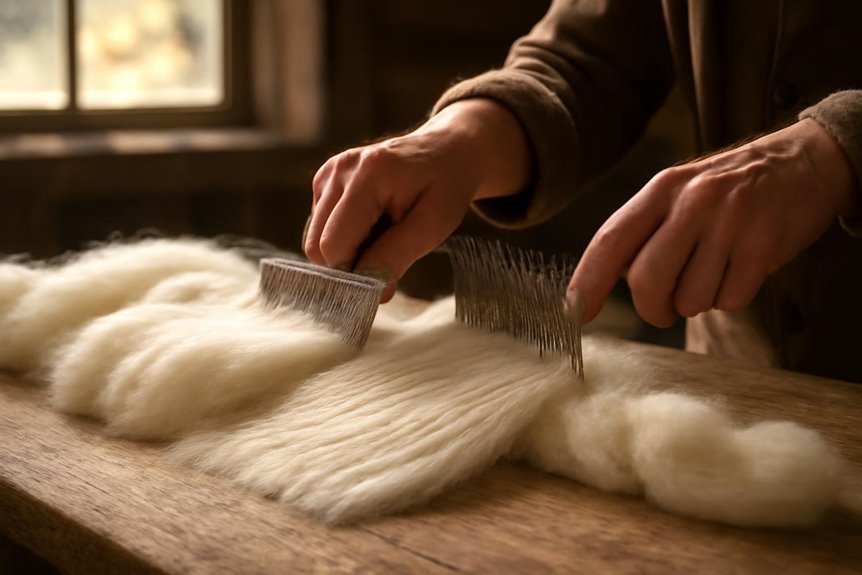
After you’ve thoroughly removed debris and second cuts from your alpaca fleece, the next step is to align the fibers for spinning. Combing techniques using St. Blaise combs help you achieve this by pulling the fiber over the tines, covering about half their height. Then, use a second comb to transfer the fibers away from your body, creating a continuous strand called “top.” This process removes shorter strands, ensuring uniformity and high quality. To reduce static and make fiber alignment smoother, lightly spritz the fibers with water before combing. Keep in mind, combing is ideal for most alpaca fibers, but for longer, finer Suri fiber, carding is usually preferred. Mastering these combing techniques will give you well-prepared fiber ready for spinning.
Carding Methods for Fiber Preparation
When preparing alpaca fiber, you’ll notice combing and carding serve different purposes—combing aligns fibers for smooth yarn, while carding creates fluffy batts. If you’re handling larger batches, a drum carder can save you a lot of time and effort compared to hand carding. Understanding these differences helps you choose the best method for your fiber’s texture and your project’s needs.
Combing vs. Carding
Although both combing and carding prepare alpaca fiber for spinning, they serve different purposes and suit different fiber types. Combing aligns fibers and removes short strands to create a continuous, uniform “top,” ideal for huacaya fiber. Carding uses drum or hand carders to produce fluffy batts or rovings, perfect for blending colors and handling longer Suri fiber.
Here’s a quick comparison:
- Combing uses St. Blaise combs to remove neps and short fibers.
- Carding involves passing fiber through drum carders multiple times for fluffiness.
- Combing results in a smooth, aligned fiber strand.
- Carding creates airy batts, making spinning easier and color blending possible.
Choose combing or carding based on your fiber type and desired end product.
Drum Carder Benefits
If you’re leaning toward carding rather than combing your alpaca fiber, a drum carder can make the process much more efficient. This tool aligns and fluffs fibers into smooth batts or rovings, ready for spinning or felting. The Strauch Finest Single Wide drum carder is a popular choice, letting you pass your fiber through up to three times for consistent quality. Unlike hand cards, a drum carder handles larger batches, perfect for small farms aiming to boost productivity. You can also blend different alpaca fiber colors during carding, creating unique fiber nests that add character to your yarn. Plus, the drum carder removes shorter fibers and neps, ensuring a uniform, tangle-free batt that’s essential for high-quality spinning.
Blending and Dyeing Alpaca Fibers
Since alpaca fibers lack elasticity, blending them with wool, mohair, silk, or angora can give your yarns more strength and versatility. When you focus on blending alpaca fibers, you enhance their usability for various projects. For dyeing, use acid dyes made for protein fibers to get vibrant, lasting colors. Follow these steps for blending and dyeing alpaca fibers:
- Blend fibers during carding to create unique color mixes and stronger yarn bases.
- Test dye lots on small fiber samples to verify color accuracy.
- Soak fibers in a controlled-temperature acid dye bath to achieve even coloration without felting.
- Experiment with blending different colors to produce one-of-a-kind fiber nests before spinning.
This approach maximizes your fiber’s potential and color outcomes.
Spinning and Finishing the Yarn
Now that your fibers are prepared, it’s time to spin them into yarn using techniques like drafting singles with a woolen method for a soft texture. You’ll also want to ply the singles together to add strength and durability. Once spun, finishing steps like setting the twist and washing guarantee your yarn is ready for your next project.
Spinning Techniques Overview
Spinning alpaca fiber into yarn involves several key steps to confirm consistency and strength. Using a spinning wheel, you draft the fiber into singles on a bobbin, maintaining an even twist and uniform thickness. Plying then twists two or more singles together to create balanced yarn that resists unraveling. Employing tools like a Lazy Kate lets you hold multiple bobbins while plying, making the process smoother. The spinning technique you choose—woolen or worsted—affects the yarn’s texture and drape, depending on how you prepare the fiber.
Here’s a quick overview:
- Draft fiber into singles using your spinning wheel.
- Use a Lazy Kate to ply singles together.
- Choose spinning style (woolen or worsted) based on desired yarn qualities.
- Confirm balanced yarn for durability and strength.
Yarn Finishing Methods
Although the yarn looks complete once it’s off the bobbins, finishing it properly is key to guaranteeing durability and usability. Yarn finishing methods start by washing the spun yarn to remove oils and dirt, then setting the twist by submerging it in cold water. This stabilizes the yarn’s structure and prevents unwanted unraveling. After washing, you’ll want to count and measure your yarn to determine yardage, making future project planning much easier. Using a tool like a Niddy Noddy helps organize the yarn into neat skeins for storage or sale. Don’t forget to tag your finished yarn with fiber content and yardage details—this simple step keeps your materials tracked and ready for specific uses. Proper yarn finishing methods guarantee your alpaca fiber looks great and performs well.
Frequently Asked Questions
How to Process Alpaca Fleece for Beginners?
Imagine clouds in your hands; start fleece preparation by skirting to remove debris, then gently wash without agitation, dry while fluffing, and finally comb or card the fiber to prepare it smoothly for spinning into yarn you’ll cherish.
How Much Can One Ounce of Alpaca Fiber Sell For?
You can expect fiber pricing for one ounce of alpaca fiber to range from about $2 to $3, depending on quality and processing. Higher-quality, well-processed fiber in desirable colors often fetches premium prices.
How Profitable Are Alpaca Farms?
You’ll find alpaca farm profitability hinges on factors like fiber quality, market demand, and diversification. With raw fleece selling $2-$5 per pound and processed yarn up to $30, smart strategies boost your income potential markedly.
How Is Alpaca Fiber Processed?
You start by shearing your alpacas for fiber quality, then skirt and wash the fleece carefully. Afterward, card or comb the fiber, and finally spin it into yarn, ensuring the best fiber quality throughout.

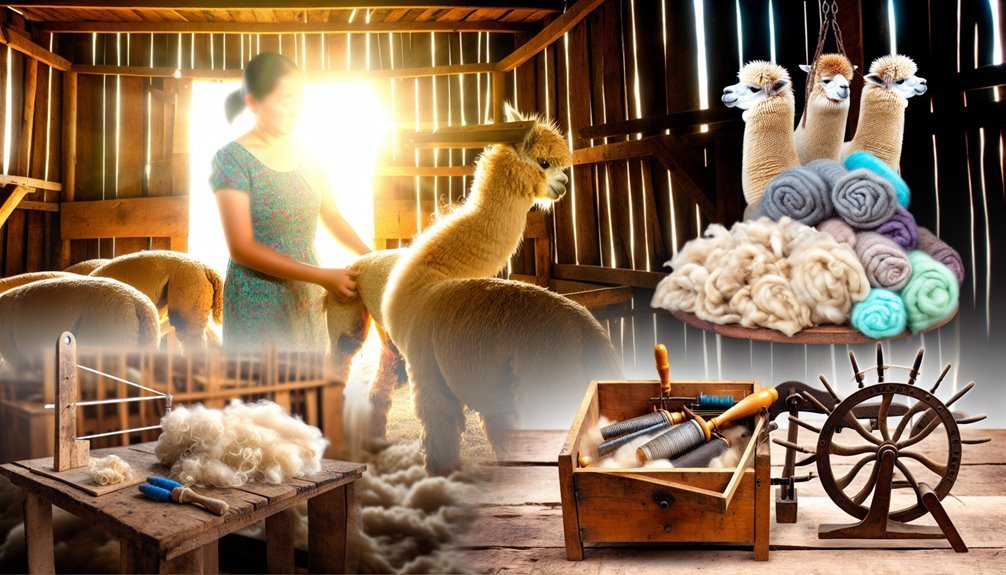




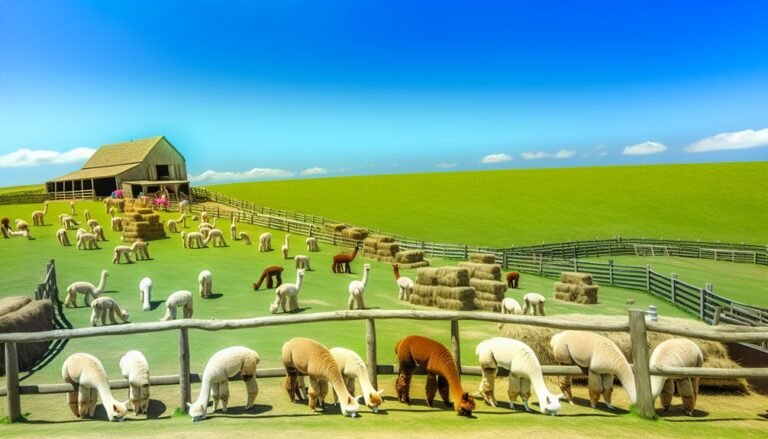

Our picks
Alpaca & Wool Felted Sole Inserts: Comfy Upgrade?
Best Alpaca Socks for Hiking: Ultimate Comfort and Durability on Trails
Best Alpaca Halter for Comfort and Control